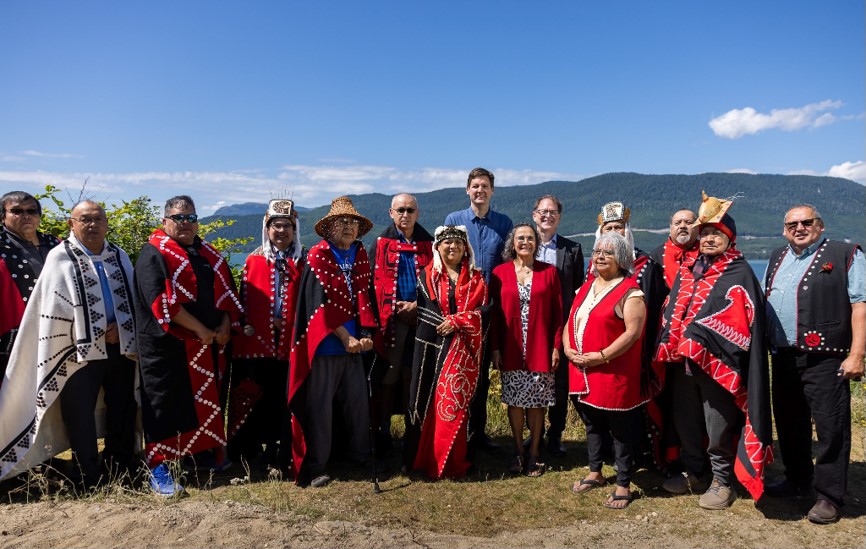
Summary
- Indigenous equity ownership rising in Canadian energy projects
- First Nation taking on up to C$1.4 billion in debt to finance stake
- Some other LNG projects face Indigenous opposition
(Reuters) – When Maureen Nyce, the new chief of the Haisla First Nation, donned a hard hat and safety vest for an August visit to the site of the Cedar LNG pipeline, she did so not as a visiting dignitary or cultural emissary – but as an owner.
The Haisla – who have occupied territory on Canada’s Northwest coast for 9,000 years – own a 50.1% equity stake in the $4-billion Cedar LNG export project near the town of Kitimat, British Columbia. Calgary-based Pembina Pipeline owns the remainder.
The world’s first majority-Indigenous-owned LNG project, expected to be operational in 2028, could drastically change the future of Nyce’s people and serves as a test case for Canada, which has just started exporting LNG to Asia and is trying to reduce export reliance on the United States.
But getting Cedar LNG from the idea stage to reality was dependent on a number of unique factors, Reuters learned during a site visit and from Nyce’s first media interview since she became chief in July.
The project benefited from strategic use of existing infrastructure, near-unanimous community support, and a massive, first-of-its-kind loan – a combination that could be difficult to replicate as Canada, the world’s fifth-largest natural gas producer, seeks to strike a balance between Indigenous rights and economic growth.
In Canada, energy partnerships with Indigenous groups are normally initiated by industry but Cedar LNG was Indigenous-led from the beginning.
One crucial component was a 2018 deal that gave the Haisla access to 400 million cubic feet per day of capacity on the 670-km Coastal GasLink pipeline that brings natural gas to the larger Shell-led LNG Canada facility.
LNG Canada – which this year shipped Canada’s first LNG to Asia – also sits on Haisla land. To secure Haisla support for the project, Shell and other LNG Canada proponents started consultations with the First Nation in 2013.
While some in the community had early concerns, especially around environmental impacts, many Haisla felt the industry’s growth was inevitable.
“It was viewed by our people as, ‘we can either jump on board, or we can get off and leave it and get left behind,'” Nyce said.
Leadership saw a rare opportunity to invest in the future, in a community where many live below the poverty line.
The Haisla negotiated direct financial payments from LNG Canada, but Dave LaVallie, the Nation’s business development officer at the time, urged the council to push for access to Coastal GasLink shipping capacity.
The Haisla were then able to search for a private-sector partner to help build their own LNG facility.
Pembina Pipeline was looking for opportunities after canceling its Jordan Cove LNG project in Oregon due to opposition from landowners, environmentalists and Indigenous groups.
The Haisla had guaranteed pipeline access as well as community endorsement early on, said Stu Taylor, Pembina’s senior vice-president and corporate development officer.
“What boards want, what executive teams want, is that certainty,” Taylor said.
The Haisla initially chose a smaller developer, Taylor said, but Pembina bid on the project a second time after the Haisla realized they needed a larger company with more financial heft behind them. They signed a partnership agreement in 2021, Pembina’s first such equity deal with an Indigenous community.
“We had all the normal concerns,” Taylor said. “Can they fund the project, what capabilities do they have, how are you going to manage the joint venture, does the community support it?”
Pembina’s original vision involved the Haisla owning a minority stake, but “the Haisla, right from the very start, had a vision of being the majority owner,” he said.
The Cedar LNG board consists of four Haisla directors and four directors from Pembina.
DIVISIVE ISSUE
Partnering with Indigenous communities, encouraged by Canadian Prime Minister Mark Carney, can help projects win regulatory approval.
In Canada, 73% of the 504 major resource and energy projects under way or proposed run through or are within a 20-km radius of Indigenous territories.
But in some cases, Indigenous equity ownership has not deterred opposition and deals can still fall apart.
Pipeline operator TC Energy in February terminated a highly publicized deal to sell a minority stake in its Canadian natural gas pipeline system to Indigenous communities for C$1 billion, according to a securities filing.
TC declined to say why and the communities did not respond to requests for comment.
Approximately 230 km north of the Cedar project, the Ksi Lisims LNG project, proposed by Houston-based Western LNG and a consortium of Canadian natural gas producers, faces community pushback.
The Nisga’a Nation has purchased an equity stake in the pipeline being built to supply Ksi Lisims and supports the project. But it is opposed by other Indigenous groups, including the Gitanyow Hereditary Chiefs, who last year blockaded service roads to protest the pipeline’s construction through their traditional territory and fear an impact on local salmon populations.
The federal government approved Ksi Lisims on September 15 but the Gitanyow say they will continue to fight the project, possibly through the courts.
Tara Marsden, sustainability director for the Gitanyow Hereditary Chiefs, worries industry proponents are using Indigenous partnerships to give their projects the perception of widespread social license.
“(LNG) is not unanimously supported, and it is a divisive issue for many people,” Marsden said.
There are 165 energy and related infrastructure projects across Canada partially or wholly owned by Indigenous communities, and 29% of those equity agreements were announced within the last two years, according to law firm Fasken.
The Haisla worked closely with Pembina’s finance team to secure funding. Sixty percent of the project will be funded by a construction term loan with a syndicate of banks, while 40% will be financed through equity contributions from both partners.
The Haisla ultimately borrowed C$1.4 billion from the First Nations Finance Authority, a non-profit corporation owned and controlled by First Nation governments, to fund their share, Nyce said. It is the largest loan the FNFA has issued to date, and one of the largest ever issued to a First Nation in Canada.
In a ratification vote last year, nearly 93% of Haisla members voted in favour of borrowing money for the project.
Nyce declined to put a dollar value on the revenues the Haisla expect from Cedar LNG. She said it will be at least a decade until significant revenues flow to the community rather than paying off debt.
Even so, she and other council members are putting plans in place – for housing, for education and training programs, for health and social supports for community members.
“This is our territory. When this project is gone, we’ll still be here,” Nyce said.
Reporting by Amanda Stephenson in Kitimat and Hazelton, British Columbia; Editing by Caroline Stauffer and Nia Williams
Share This:




 CDN NEWS |
CDN NEWS |  US NEWS
US NEWS 































